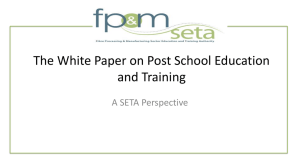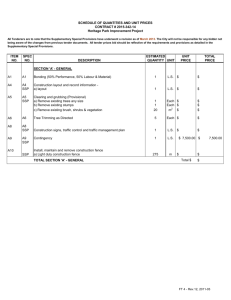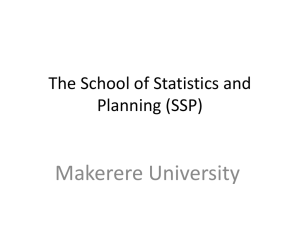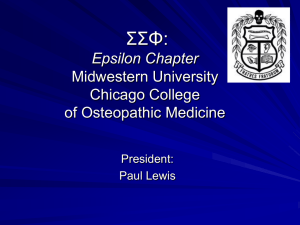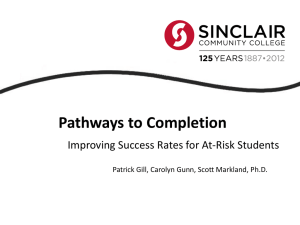Sector Skills Plan (SSP)
advertisement
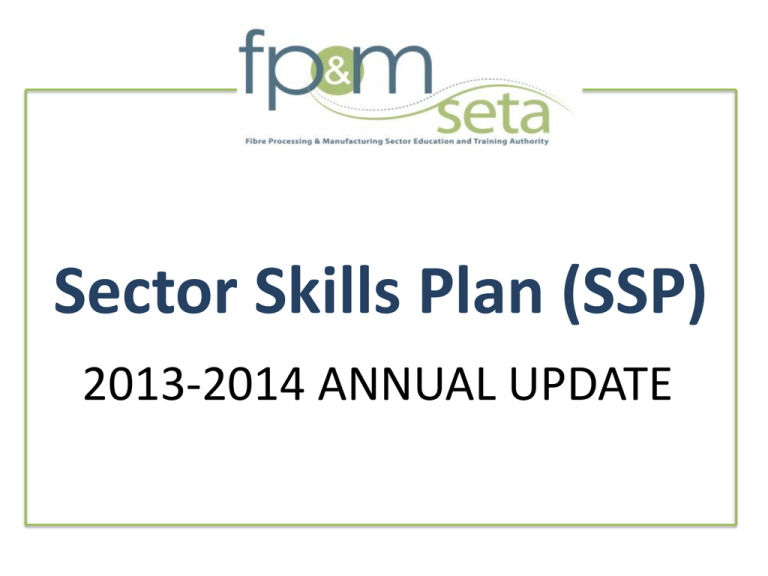
Sector Skills Plan (SSP) 2013-2014 ANNUAL UPDATE SSP 2013-2014 Annual Update • 2013-2014 Annual Update have been evaluated by the DHET. • DHET recommended the submission for approval • SSP en route to the Minister for sign-off. • Critical areas of focus for 2014-2015 Annual Update. Key Challenges of the SSP • To facilitate the delivery of sector-specific skills interventions: – to meet the goals of the NSDS III – to address employer skills demand that deliver return on investment. • To grow labour market intelligence; and • To ensure industry skills needs and strategies address the requirements of all employers within the FP&M sector. – levy-paying and non-levy paying, formal and informal Sector Skills Analysis • Purpose • Determine sector specific objectives and goals to meet sector needs, • Develop economic or industrial sector growth strategies, • Identify activities that will support these strategies, • Develop scenarios pertaining to skills demands per subsector, • Address scarce and critical skills in the sector, • Propose a high level strategic approach to meet the sectors’ skills development needs in the short, medium and long term Sector Skills Analysis • Informed by: • the industry profile; • growth demand and replacement demand forecasts; • analysis of WSP / ATR submissions; and • stakeholder consultation sessions conducted by the – SETA during the development of the SSP. Critical Factors across FP&M Sector • Main replacement demand factor: aging workforce. • Critical skills driver: new equipment. • Critical skills: Management and Leadership; Multi-skilled workers. • Scarce skills: Technical artisan skills ( especially; mechanical engineers; technicians; mechanics; quality controllers); • Challenges with existing provision: none or limited external training capacity due to specialisation. • Bridging programmes: from AET to higher levels, to enable progression toward supervisory level; RPL SSP Strategies • “Re-tooling” of unemployed graduates. • Placement of unemployed learners and graduates. • Addressing scarce and critical skills incl • Provision of middle level skills; • Training of Artisans and Artisan Aides • Transformation of public service facilities into training space. • Recognition of Prior Learning (RPL). • Expansion of SETA presence into rural areas. • Assistance to the informal sector. • Partnerships with Universities and FET colleges. Priority Interventions arising from the SSP • Support strategies to prevent job loss, to maintain employment and assist towards growth – – Training Lay-off Scheme – Local Procurement Strategy – Management and Leadership Development (to prevent industry “brain drain”). Priority Interventions arising from the SSP • New forms of partnerships to achieve “collaborative clustering” that underpins turnaround strategies and ensure economies of scale. This includes partnerships: – between public and private providers; – along the skills pipeline (schools, FET colleges and HEIs); – between providers and workplaces; – between SETAs; and – between local and international providers (where SA lacks the relevant expertise). Priority Interventions arising from the SSP • Improving supply-side efficiency and effectiveness (RoI) – Current throughput rates cannot be justified; • Innovation in skills development – the turn-around in industry cannot be achieved through “training as usual”; • Innovative and informal strategies – succession planning, internships, coaching/mentoring and work integrated learning; – targeted HIV/AIDS education, treatment and prevention strategies; and – coordination of skills development efforts with other policy instruments Priority Interventions arising from the SSP • Mitigation of replacement demand, and • Promotion of categories of critical skills development – – lecturer capacity building to align curricular content to industries need; – lecturer exposure to industry. Growth Prospects • The growth prospects for the FP&M sector remain unchanged for the future unless: – the sector fundamentally restructures itself, – improves programme offering and funding. – Invest in research and development across all 13 sub sectors • Over the next 5 years - growth vs. retention of market share. • If the DTI strategy is successful, growth may be an option post 2015. • Value Chain investigation may lead to new opportunities. Mechanisms to Strengthen SSP • Strategic Plan and Sector Skills Plan Framework. • SETA Constitution (SETA SSP Forum, provincially). • Partnerships with HEIs and FETs • for research and capacity building. • to grow supply side • • • • Geographical SETA presence. Repository of SETA research. SETA research surveys. Credible mechanism for planning. Mechanisms to Strengthen SSP • SETA support engagements with DHET and other SETAs (SETA Forum, Provincial Clusters, PSDF) • Development of Continuous Improvement Plans. • Career Advise Framework (feeder from GETs, FETs, HETs). • Organising Framework for Occupations (OFO). Thank you! Comments/Questions?
